 W
WAmmophila is the type genus of the subfamily Ammophilinae of the hunting wasp family Sphecidae. Ammophila is a large and cosmopolitan genus, with over 200 species, mostly occurring in the warmer regions of all continents apart from Antarctica.
 W
WAmpulex is a large cosmopolitan genus of wasps belonging to the family Ampulicidae. Most of the >130 species occur in the tropics, particularly in the Old World, and fewer than 15 are known from the New World; fewer than 5 species are native to Europe or the United States, though the Old World species Ampulex compressa has spread to virtually everywhere that its host roaches can be found. The few species whose biology is known are parasitoids of cockroaches; they typically inject venom into the roach that subdues or immobilizes it, and then lay one to two eggs between the legs of the defenseless roach.
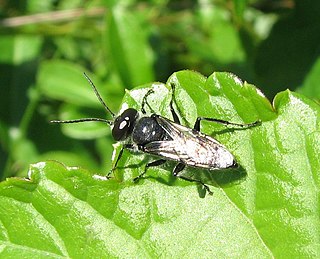 W
WAstata is a cosmopolitan genus of solitary predatory wasps in the subfamily Astatinae. They are known to prey on adults and nymphs of Pentatomidae. Astata is the largest genus in this subfamily, and is identified by features of its wing venation. The males of this genus and the related genus Dryudella have very large compound eyes that broadly meet at the top of the head.
 W
WBeewolves, also known as bee-hunters or bee-killer wasps, are solitary, predatory wasps, most of which prey on bees, hence their common name. The adult females dig tunnels in the ground for nesting, while the territorial males mark twigs and other objects with pheromones to claim the territory from competing males.
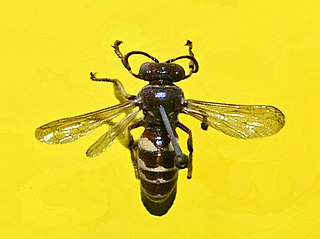 W
WBembecinus is a cosmopolitan genus of sand wasps belonging to the family Crabronidae. There are at least 200 described species in Bembecinus.
 W
WBembix is a large cosmopolitan genus of large, often brightly colored predatory sand wasps, consisting of about 380 species.
 W
WBicyrtes is a genus of large, often brightly coloured predatory sand wasps. Many species in this genus provision their nests with paralyzed Pentatomidae, while other species make use of Reduviidae and Coreidae instead.
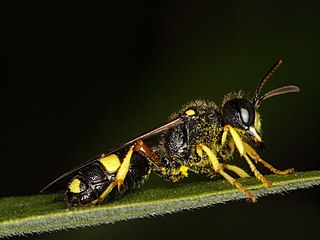 W
WCerceris is a genus of wasps in the family Crabronidae. It is the largest genus in the family, with over 1030 described species and subspecies. The genus has a cosmopolitan distribution, with species on every continent.
 W
WCrabro is a genus of square-headed wasps belonging to the family Crabronidae. There are at least 80 described species in Crabro, found in the Nearctic and Palaearctic (Holarctic).
 W
WCrossocerus is a genus of square-headed wasps in the family Crabronidae. There are at least 250 described species in Crossocerus.
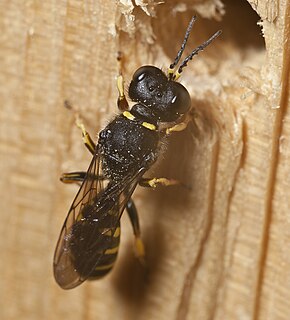 W
WEctemnius is a genus of wasps in the family Crabronidae. 188 species are known. The genus is found around the world but Australia has only two species.
 W
WThe Australian cicada killer wasp, Exeirus lateritius, the sole member of the genus Exeirus, is a large, solitary, ground-dwelling, predatory wasp. It is related to the more common genus of cicada killers, Sphecius. In Australia, E. lateritius hunts over 200 species of cicada.
 W
WGorytes is a genus of sand wasps in the family Crabronidae. There are at least 70 described species in Gorytes.
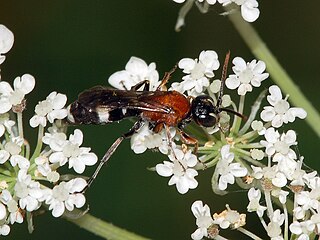 W
WHarpactus is a genus of hunting wasps in the tribe Gorytini.
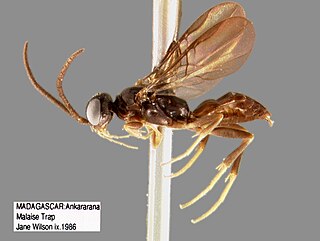 W
WHeterogynaidae is a minor and disputed lineage of small spheciform wasps occurring in Madagascar, Botswana, Turkmenistan, Oman, the United Arab Emirates, and the Eastern Mediterranean area. The majority are dark in color and range in size from approximately 1.5 to 5.0 mm. Most specimens have been collected in arid climates, but one species from Madagascar is known to occur in a humid forest habitat. Although males have functional wings, heterogynaid females are typically brachypterous, a trait which is unique among spheciform wasps. Wing venation is reduced in both sexes. All species are diurnal, with the exception of H. nocticola. Other aspects of their biology are completely unknown, but details of their morphology have prompted researchers to hypothesize that they may be non-fossorial parasitoids adapted to hunt in tight spaces, such as under tree bark. This is speculative and has not yet been confirmed by actual observations of behavior. It is also possible that modifications of the female metasomal tergum VI and gonostyli may represent a unique prey transport mechanism, but this is also unconfirmed.
 W
WLindenius is a genus of wasps in the family Crabronidae. Most species are found in the Palearctic a few are Nearctic.63 species are known
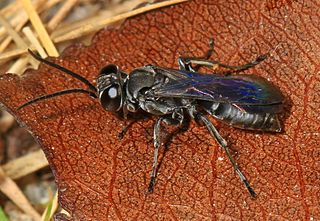 W
WLiris is a genus of solitary, ground-nesting, predaceous wasps, containing over 300 species. It contains two subgenera: Leptolarra and Motes, with most of the species falling within subgenus Leptolarra.
 W
WMegalara garuda, colloquially referred to as the "King of Wasps", is a large wasp and the only species in the genus Megalara, family Crabronidae, tribe Larrini. It is only known from the Mekongga Mountains in the southeastern part of the Indonesia island of Sulawesi. It was described in 2012 by Lynn Kimsey, director of the Bohart Museum of Entomology and professor of entomology at the University of California, Davis, and Michael Ohl, curator and head of entomology at the Museum für Naturkunde, Berlin. Rosichon Ubaidillah from the Indonesian Institute of Sciences also contributed the discovery.
 W
WMimumesa is a genus of wasps in the family Crabronidae. The species are found in the Holarctic. 32 species are known to exist.
 W
WBeewolves, also known as bee-hunters or bee-killer wasps, are solitary, predatory wasps, most of which prey on bees, hence their common name. The adult females dig tunnels in the ground for nesting, while the territorial males mark twigs and other objects with pheromones to claim the territory from competing males.
 W
WPrionyx is a genus of wasps in the family Sphecidae. They are known to hunt and feed on grasshoppers.
 W
WPsenulus is a genus of wasps in the family Crabronidae. The 160 species are found worldwide, but are best represented in the Indomalayan realm with 68. The Palearctic has 26, the Nearctic 4, and the Australasian realm 3. Psenulus is largely absent from South America and entirely absent from Melanesia and Polynesia. A recent phylogenetic analysis provided strong evidence that this genus is the closest living relative to bees.
 W
WSceliphron, also known as black mud daubers or black mud-dauber wasps, is a genus of Hymenoptera of the Sphecidae family of wasps. They are solitary mud daubers and build nests made of mud. Nests are frequently constructed in shaded niches, often just inside of windows or vent openings, and it may take a female only a day to construct a cell requiring dozens of trips carrying mud. Females will add new cells one by one to the nest after each cell is provisioned. They provision these nests with spiders, such as crab spiders, orb-weaver spiders and jumping spiders in particular, as food for the developing larvae. Each mud cell contains one egg and is provided with several prey items. Females of some species lay a modest average of 15 eggs over their whole lifespan. Various parasites attack these nests, including several species of cuckoo wasps, primarily by sneaking into the nest while the resident mud dauber is out foraging.
 W
WWasps of the genus Sphex are cosmopolitan predators that sting and paralyze prey insects. Sphex is one of many genera in the old digger wasp family Sphecidae, though most apart from the Sphecinae have now been moved to the family Crabronidae. There are over 130 known Sphex species.
 W
WStictia is a largely neotropical genus of large, often brightly colored predatory sand wasps, consisting of about 30 species.
 W
WStizus is a genus of sand wasps belonging to the family Crabronidae. There are over 100 species.
 W
WTachysphex is a genus of square-headed wasps in the family Crabronidae. There are at least 440 described species in Tachysphex.
 W
WTachytes is a genus of predatory, solitary wasps, containing about 300 species.